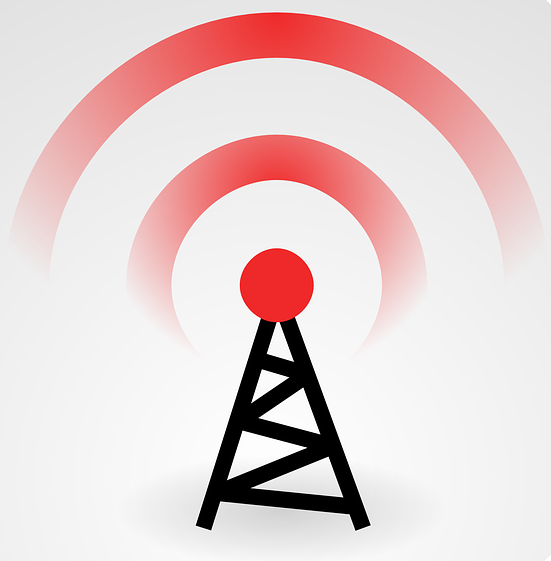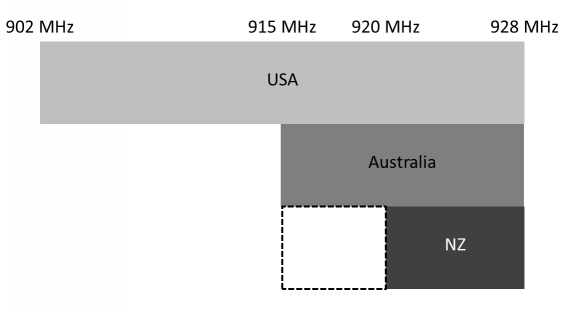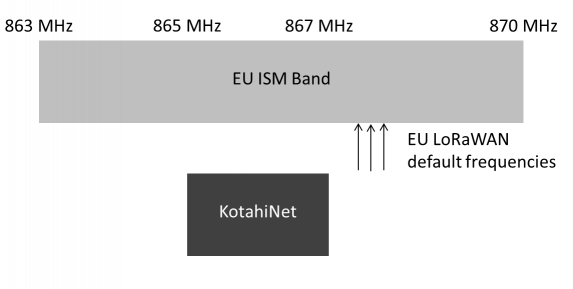
IMPORTANT UPDATE: KotahiNet’s band plan as detailed in this blog post is no longer used. While the reasons for choosing the band plan within 864-868 MHz remain the same, the current band plan aligns the specific frequencies used with that of the Indian market. Our reasoning is detailed in another blog post.
There have been a few questions about the frequencies KotahiNet uses and why. This includes pointed questions and an inspection by the good people responsible for its management in New Zealand, the Radio Spectrum Management (RSM) office.
Sub-GHz ISM bands in NZ
Operating at MHz rather than GHz frequencies has advantages in terms of better coverage. Within the sub-GHz range, the interest from network operators for LoRaWAN (and other similar wireless) networks is to use public spectrum so that there is no explicit cost or licence necessary. According to the latest regulations (updated 28 January 2016), the three practical bands are 433.05 to 434.79 MHz, 864 to 870 MHz, and 915 to 928 MHz.
Besides the varying conditions imposed on these three bands, the two major factors to evaluate the best option are noise and alignment with global bands. Noise in the radio spectrum can vary geographically in New Zealand which implies that compromises may be required to operate at a uniform national frequency.
LoRaWAN specifications
The second major factor is to align with specifications so that a global supply base is available. In hardware, prices are highly dependent on volumes and it is almost impossible for any New Zealand company to operate outside of international off-the-shelf equipment availability.
The current LoRaWAN 1.0 specification has four bands for Class A devices:
- EU 863-870 MHz which has three (default) channels that every network gateway must listen to- 868.1, 868.3 and 868.5 MHz.
- US 902-928 MHz which has no default channels. Instead, the specifications are 64 upstream (i.e. from end device to gateway) channels from 902.3 to 914.9 MHz, 8 upstream channels from 903.0 to 914.2 MHz, and 8 downstream channels from 923.3 to 927.5 MHz.
- China 779-787 MHz which is not possible under New Zealand regulations at all, and
- EU 433 MHz which has three default channels- 433.175, 433.375 and 433.575 MHz.
Initial Analysis
Combining the LoRaWAN 1.0 specifications with New Zealand regulations:
- EU 863-870 MHz: New Zealand regulations for 868 to 870 MHz, in which the three default frequencies lie, specify “the maximum power is –27 dBW (2 mW) e.i.r.p. and the maximum permitted duty cycle is 1%”. Both the permissible power and duty cycle limitations rule out this option practically.
- US 902-928 MHz: not possible as all upstream channels lie outside the New Zealand permissible range of 915 to 928 MHz.
- EU 433 MHz: theoretically possible but the amount of noise in this part of the spectrum is very high, especially due to Chinese origin products and there is no limit on the maximum permissible power. Additionally, this is quite a narrow band.
In summary, it is very difficult but not impossible to meet both LoRaWAN 1.0 specifications and New Zealand spectrum regulations. The only option is EU 433 MHz. While it is attractive in terms of being able to buy from Chinese suppliers at low prices, in practice it is impossible to run a carrier grade network in New Zealand with any sort of reliability in that band.
The Aus option
The problem we have is not unique. Many operators outside the LoRaWAN 1.0 spec countries of EU, USA and China are facing the same issues due to misalignment of public ISM bands globally.
For Australia, the soon to be released LoRaWAN 1.0.1 spec version will be somewhat similar to USA- 64 upstream channels from 915.2 to 927.8 MHz, 8 upstream channels from 915.9 to 927.1 MHz, and 8 downstream channels from 923.3 to 927.5 MHz.
With New Zealand’s band 915 to 928 MHz, is it a good choice to adopt Australia’s band and use equipment tailored for their market?
Between 915 and 920 MHz, the maximum allowable power is 0.0 dBW (1 W) and from 920 to 928 MHz it is 6.0 dBW (4 W). That makes the lower end of the New Zealand band difficult to use in practice.
Therefore, within the narrower band of 920 to 928 MHz, New Zealand operators will be able to use LoRaWAN equipment meant for Australia rather than the whole Australian 915 to 928 MHz band. The only condition is to ensure the equipment does not exceed the unwanted emission limits specified by New Zealand radio regulations.
On the downside, there is quite a bit of noise in the 920 to 928 MHz band in New Zealand due to pre-existing usage. For example, there are already over a million smart electricity meters operating in these frequencies.
For those who want to use this option, a note of caution. There are a number of suppliers selling “LoRaWAN 915 US/Aus/NZ” equipment. Some of these can be configured to operate only in the New Zealand band of 920 to 928 MHz and can therefore be used. Despite the labeling, many of them can’t be so configured and are therefore illegal to operate in New Zealand.

LoRaWAN specifications for upstream channels
KotahiNet’s approach
Since there is configuration required for international off-the-shelf equipment to meet New Zealand radio spectrum regulations in any case, our approach is to use the 865 to 867 MHz band where there is less noise. This is based on the wider EU ISM band 863-870 MHz. However, since KotahiNet does not operate at the three mandatory EU spec frequencies of 868.1, 868.3 and 868.5 MHz, it is not strictly compliant with LoRaWAN 1.0 specifications.
KotahiNet’s band plan is:
| Channel | Frequency (MHz) | Bandwidth (kHz) | Sp Factor/Data Rate |
|---|---|---|---|
| 0 | 865.0 | 125 | 12-7/0-5 |
| 1 | 865.2 | 125 | 12-7/0-5 |
| 2 | 865.4 | 125 | 12-7/0-5 |
| 3 | 866.2 | 125 | 12-7/0-5 |
| 4 | 866.4 | 125 | 12-7/0-5 |
| 5 | 866.6 | 125 | 12-7/0-5 |
| 6 | 866.8 | 125 | 12-7/0-5 |
| 7 | 867.0 | 125 | 12-7/0-5 |
| 8 | 865.6 | 250 | 7/5 |
- RX2 window: 867.2 MHz
- Max power: 36 dBm
- Coding rate: 4/5
- Duty cycle: 0 (no duty cycle)

KotahiNet’s band in relation to EU frequencies
Implications for KotahiNet’s customers
KotahiNet’s choice of band plan has the following implications for customers:
- We have the ability to operate a reliable and high quality carrier-grade LoRaWAN network in New Zealand complying with radio spectrum regulations.
- No duty cycle limitations and generous permissible transmit power up to 36 dBm. Note that most off-the-shelf equipment is generally available at a lower level of 14 or 20 dBm to comply with EU regulations. This is fine.
- Wide choice of global suppliers who can supply LoRaWAN EU 868 equipment off-the-shelf right now. Note that LoRa modules used by customers must be configurable to operate in the band plan above and the three mandatory default EU channels must be switched off or disabled. For example, see how to configure Microchip’s RN2483 module.
You may also be interested in Low Power Satellite IoT


Do you think that IoT network businesses building their infrastructure around wireless technologies utilising ISM bands (such as LoRa and SigFox) are able to provide a credible long term IoT service offering? While the lack of licensing fees are attractive from an operator and customer perspective (on the face of it), the network operator exerts no control over who else is also making use of that spectrum. Due to the relatively low cost of rolling out LoRaWAN infrastructure, it might be expected that there will be increasing use of the 868MHz ISM band by private and/or public LoRaWAN and other types of IoT networks in NZ as time goes on. Might this cause service reliability issues for you?
I’m just playing devils advocate here. I am very much interested in the technology and your particular roll out and wish you all the best.
Thanks
Richard
That’s a good point Richard. KotahiNet’s decision to use 865-867 MHz is partly in response to other ISM bands being popular and more heavily used. A critical aspect of public bands is that everyone plays by the rules, for example adhering to limits on transmitted power or duty cycles (where applicable).
As to the larger question of long-term service offering based on ISM bands, I think the example of wifi shows that it is possible and that as usage grows, solutions become available. LoRa in particular has been specifically designed to operate in very noisy conditions and is therefore well suited to the ISM bands.
As of 24 Dec 2015 New Zealand has opened up the allowable SRD band to 915-928 MHz (expanded from the previous 921-928 MHz). Which now matches Australia
http://www.rsm.govt.nz/about-rsm/spectrum-policy/gazette/gurl/short-range-devices
Hi Vikram
With the Lora v1.0.2 spec defining NZ as using the SRD frequencies between 915-928 MHz, will Katahi.Net be shifting from using the EU 868Mhz frequencies?
Thanks
Julian
Hi Julian, thanks for asking. No, KotahiNet will not shift frequencies. We have found the 865-867 MHz band at which we currently operate to be excellent. Our continued reservation about the 915-928 MHz band is the noise, making it harder to offer a carrier-grade reliable service in that band. Our understanding is that India is also planning to use 865-867 MHz, which further cements our interest in that band.
[…] originally launched with the 865 – 867 MHz band. An earlier blog post provides more details of the […]